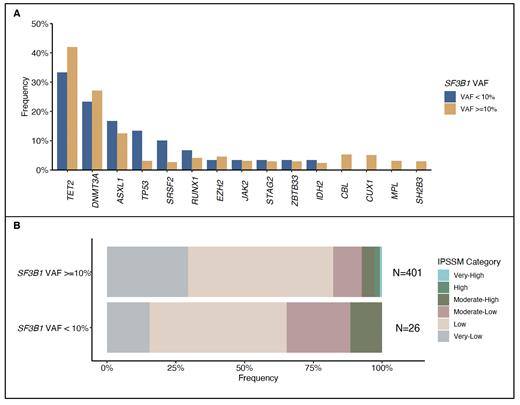Introduction:
Recent iterations of the World Health Organization (WHO) and international consensus classification (ICC) guidelines for myelodysplastic neoplasms (MDS) refined disease defining characteristics through incorporation of morphologic and genetic criteria. Despite these welcome updates, discrepancies between the WHO and ICC remain, particularly with respect to variant allele frequency (VAF) threshold in disease defining mutations such as SF3B1 and TP53. We evaluated patients with SF3B1-mutated MDS, a specific molecular class of MDS in both classification schemes , providing additional biologic and survival information to inform both diagnosis and prognosis.
Methods:
We queried the International Working Group for Prognosis in MDS (IWG-PM) cohort of adult (age ≥ 18 years) patients (pts) with MDS (N= 3,323; Bernard et al. NEJM Evidence 2022) for baseline clinical demographic, cytogenetic and molecular information, and clinical outcomes. SF3B1 VAF was assessed using targeted next generation sequencing. Demographics were analyzed using descriptive statistics. Between group differences were assessed using the Wilcoxon rank-sum test or Fisher's exact test as appropriate. Time to event endpoints were analyzed using the log-rank method. Multivariate analysis utilized cox proportional hazards regression.
Results:
We identified 447 (14%) pts met WHO 5th criteria for MDS with low blasts and SF3B1 mutation. Among these, 30 (7%) of pts had a SF3B1 VAF < 10% ( SF3B1low;currently classified as MDS, not otherwise specified by ICC) while 93% (N=417/447) had SF3B1 VAF of ≥ 10% ( SF3B1high). Median VAF in pts with SF3B1low vs. SF3B1high was 6% (range: 2.2-9.9%) vs. 37% (range: 10.9-54.1%). Pts with SF3B1low vs. SF3B1high were older (median age 79 vs. 74, p=0.010), and had lower median platelet (185 x10 9/L vs. 264 x10 9/L, p < 0.001) and white blood cell levels (3.94 x10 9/L vs. 5.46 x10 9/L , p < 0.001).
The median number of mutations other than SF3B1 in SF3B1low and SF3B1high was 2 (range: 0-5 vs. 0-8, p=0.42), and SF3B1 was the sole genetic alteration in 10% vs. 20%, respectively (OR=2.2, p=0.24). Common SF3B1 variants in SF3B1low vs. SF3B1 high included p.K666 (27% vs. 10%, OR: 0.31, p=0.01) and p.K700 (50% vs. 59%, OR: 1.42, p=0.44).
In pts with SF3B1low, single-hit mutations in TP53 (13% vs. 3%, OR: 0.21, p=0.021), SRSF2 (10% vs. 3%, OR: 0.25, p=0.06), and RUNX1 (7% vs. 4%, OR: 0.60, p=0.37) were more frequent (Fig. A). Other co-mutations had similar frequencies in SF3B1low vs. SF3B1high MDS: TET2 (33% vs. 42%, OR: 1.45, p=0.44), DNMT3A (23% vs. 27%, OR 1.22, p=0.83), ASXL1 (17% vs. 13%, OR: 0.71, p=0.57).The distribution of SF3B1 VAF, and observed patterns of co-mutations did not differ by sample type (peripheral blood or bone marrow).
More pts with SF3B1low vs. SF3B1high (76% vs. 46%, p: 0.0011) had a subclonal SF3B1 mutation compared with other co-occurring mutations. In the 213 (48%) pts with subclonal SF3B1, the most frequent dominant mutations included TET2 (35%, N=75), DNMT3A (21%, N=45), and ASXL1 (4%, N=8). Among the top co-mutations in SF3B1low vs. SF3B1high, SF3B1low was more frequently subclonal to TP53 (50% vs. 0%, p=0.04), SRSF2 (33% vs. 0%, p=0.2), and RUNX1 (50% vs. 0%, p=0.1). As anticipated, SF3B1high cases were enriched for very-low/low risk IPSS-M subtypes (78% vs. 43%, OR: 2.9, p=0.011) compared to SF3B1low cases which had an increased frequency of moderate IPSS-M subtypes (30% vs. 14%, OR: 0.39, p=0.03; Fig.B).
Median leukemia free survival (LFS; 5 vs. 6 years, p=0.10) was not significantly different between pts with SF3B1low vs. SF3B1high MDS. Median overall survival (OS; 5 vs. 6.2 years, p=0.04) was significantly shorter in pts with SF3B1low, however after adjusting for SF3B1 VAF, age, and IPSS-M score, only age (HR: 1.05 95% CI: 1.03-1.07, p < 0.0001), and increasing IPSS-M score (HR: 2.60 95% CI: 2.10-3.20, p< 0.0001) significantly associated with OS.
Conclusion:
Patients with MDS with SF3B1-mutation VAF < 10% are older and have an increased frequency of other clonally dominant co-mutations in adverse risk genes (i.e., TP53, SRSF2, RUNX1). Despite more adverse disease biology, LFS and OS were similar between pts with SF3B1low vs. SF3B1high with respect to SF3B1 VAF after accounting for age and IPSS-M score. Future diagnostic and prognostic schema could account for differences in SF3B1lowdisease biology through use of comprehensive prognostic tools such as the IPSS-M score.
Disclosures
Lachowiez:COTA Healthcare: Consultancy; Rigel Pharmaceuticals: Membership on an entity's Board of Directors or advisory committees. Gattermann:Takeda: Research Funding; BMS: Honoraria; Novartis: Honoraria. Papaemmanuil:TenSixteen Bio: Current equity holder in private company; Isabl Inc.: Current equity holder in private company, Current holder of stock options in a privately-held company, Other: CEO, Patents & Royalties: Whole genome cancer analysis. Loghavi:Caris Diagnostics: Consultancy; QualWorld: Consultancy; Daiichi Sankyo: Consultancy; Astellas: Research Funding; Blueprint Medicine: Consultancy; Gerson Lehrman Group: Consultancy; Abbvie: Consultancy; Guidepoint: Consultancy; Recordati/ EUSA Pharma: Consultancy; Amgen: Research Funding; Abbvie: Current equity holder in publicly-traded company.


This feature is available to Subscribers Only
Sign In or Create an Account Close Modal